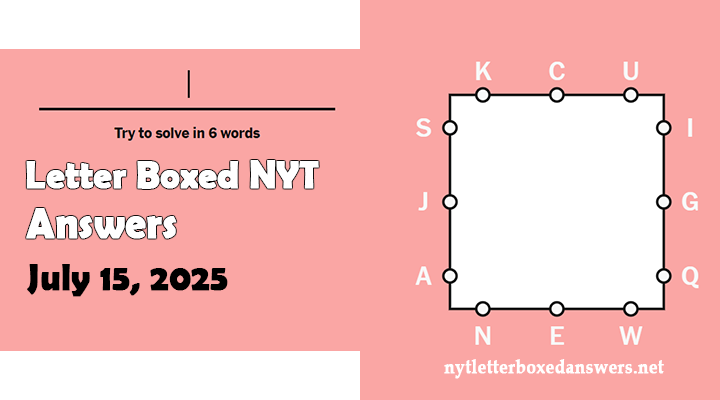NYT Letter Boxed quiz for Tuesday July 15, 2025 is released. We came up with Letter Boxed July 15 2025 Answers and Hints for you. With the help of these hints, you will be able to guess the words of letter boxed quiz without revealing the answers and get the solution.
| Top | Right | Bottom | Left |
|---|---|---|---|
| KCU | IGQ | NEW | SJA |
| Two Words Solution | ||
|---|---|---|
| JUICES | SQUAWKING | |
| JUECES | SQUAWKING | |
| Three Words Solution | ||
|---|---|---|
| CAGES | SQUAWK | KANJIS |
| CANGUES | SQUAWK | KANJIS |

Word 01:
This 6-letter word starts with J and ends with S; liquids extracted from fruits, vegetables, or meat.
Commonly consumed as beverages like orange or apple.
Can be natural, fresh-pressed, or concentrated.
Also used in cooking to enhance flavor.
Contains vitamins, especially Vitamin C.
Sometimes refers to bodily or internal fluids.
A key term in food and drink industries.
Found in phrases like “get your creative juices flowing.”
Can spoil quickly without refrigeration.
Often packaged in bottles, cartons, or cans.
Word 02:
This 9-letter word starts with S and ends with G; refers to a loud, harsh cry, especially from birds.
Commonly made by parrots, geese, and chickens.
Also used to describe loud complaints or protests.
Can mean sounding an alarm or alerting others.
Related to noisy, high-pitched vocalizations.
In slang, might refer to someone complaining persistently.
Appears in aviation as “squawk code” signals.
Used both as a noun and a verb.
Often mimicked in cartoons and children’s books.
Describes sharp, abrupt, often irritating noise.
Word 01:
This 6-letter word starts with J and ends with S; the Spanish word for “judges” (plural of juez).
Used in Spanish legal and courtroom contexts.
Refers to individuals who make rulings or verdicts.
Appears in official government and legal documents.
In charge of trials and court proceedings.
Related to justice systems across Spanish-speaking countries.
Must remain impartial and uphold law.
The root word connects to Latin iudex.
Appears in headlines discussing courts or tribunals.
Important figures in criminal and civil cases.
Word 02:
This 9-letter word starts with S and ends with G; refers to a loud, harsh cry, especially from birds.
Commonly made by parrots, geese, and chickens.
Also used to describe loud complaints or protests.
Can mean sounding an alarm or alerting others.
Related to noisy, high-pitched vocalizations.
In slang, might refer to someone complaining persistently.
Appears in aviation as “squawk code” signals.
Used both as a noun and a verb.
Often mimicked in cartoons and children’s books.
Describes sharp, abrupt, often irritating noise.
Word 01:
This 5-letter word starts with C and ends with S; enclosures used to confine or protect animals or objects.
Often made from metal bars or wire mesh.
Found in zoos, labs, and homes with pets.
May house birds, rodents, or dangerous animals.
Also symbolic of restriction or lack of freedom.
Used in wrestling or MMA as a ring structure.
Can be portable or permanently installed.
Sometimes includes food and water dispensers.
Associated with captivity or security.
Can be used to transport animals safely.
Word 02:
This 6-letter word starts with S and ends with K; a loud, harsh cry typically made by birds.
Common sound of parrots, geese, and other birds.
Can describe human complaints or protests.
Used in aviation to describe a transponder code.
Associated with alarm or panic in sound.
Harsh and unmelodic by nature.
May appear in comic books or cartoons.
Found in idioms like “don’t squawk about it.”
Often used to attract attention or signal danger.
Both noun and verb forms exist in usage.
Word 03:
This 6-letter word starts with K and ends with S; the logographic characters used in Japanese writing.
Borrowed and adapted from Chinese Han characters.
Used alongside hiragana and katakana scripts.
Can represent entire words or parts of speech.
Thousands exist, though only a few are used daily.
Essential for reading Japanese newspapers or books.
Can be complex with multiple strokes and meanings.
Studied extensively by language learners.
Includes both on’yomi (Chinese) and kun’yomi (native) readings.
Represents both sound and meaning in writing.
Word 01:
This 7-letter word starts with C and ends with S; historical Chinese punishment devices made of heavy wooden boards locked around the neck.
Used as public humiliation and restraint.
Similar in purpose to European stocks or pillories.
Prevented lying down or escaping.
Often inscribed with a criminal’s offense.
Used during imperial dynasties as deterrents.
Represented both physical and psychological punishment.
Featured in historical accounts and art.
May be referenced in discussions on penal history.
Now museum pieces or cultural artifacts.
Word 02:
This 6-letter word starts with S and ends with K; a loud, harsh cry typically made by birds.
Common sound of parrots, geese, and other birds.
Can describe human complaints or protests.
Used in aviation to describe a transponder code.
Associated with alarm or panic in sound.
Harsh and unmelodic by nature.
May appear in comic books or cartoons.
Found in idioms like “don’t squawk about it.”
Often used to attract attention or signal danger.
Both noun and verb forms exist in usage.
Word 03:
This 6-letter word starts with K and ends with S; the logographic characters used in Japanese writing.
Borrowed and adapted from Chinese Han characters.
Used alongside hiragana and katakana scripts.
Can represent entire words or parts of speech.
Thousands exist, though only a few are used daily.
Essential for reading Japanese newspapers or books.
Can be complex with multiple strokes and meanings.
Studied extensively by language learners.
Includes both on’yomi (Chinese) and kun’yomi (native) readings.
Represents both sound and meaning in writing.

Chris Brown is a passionate word game love and problem solving expert. With over 15 years of experience in solving puzzle challenges, he provides daily NYT Letter Boxed answers, tips and strategies to help other players so that they can improve their solving skills. Whether you are stuck on a tricky puzzle or looking for new techniques, Chris is here to guide you with his expert solutions.